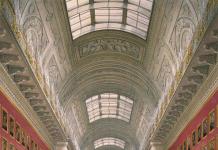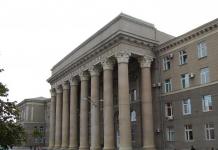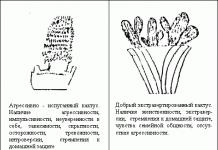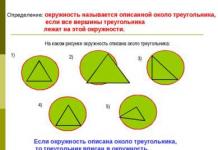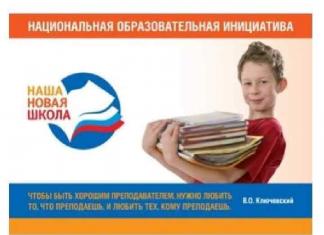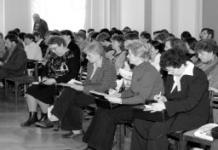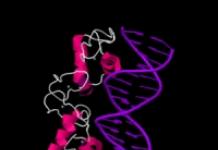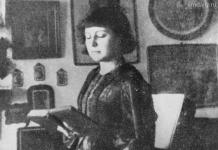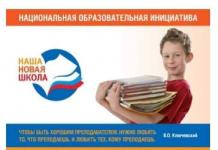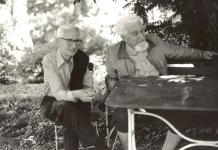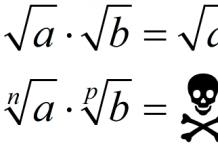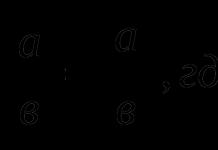The famous European scientist Johann Carl Friedrich Gauss is considered to be the greatest mathematician of all times. Despite the fact that Gauss himself came from the poorest strata of society: his father was a plumber and his grandfather was a peasant, fate destined him for great glory. The boy already at the age of three showed himself to be a child prodigy; he could count, write, read, and even helped his father in his work. 
The young talent, of course, was noticed. His curiosity was inherited from his uncle, his mother's brother. Carl Gauss, the son of a poor German, not only received a college education, but already at the age of 19 was considered the best European mathematician of that time.
- Gauss himself claimed that he began to count before he spoke.
- The great mathematician had a well-developed auditory perception: once, at the age of 3, he identified by ear an error in the calculations performed by his father when he was calculating the earnings of his assistants.
- Gauss spent quite a short time in the first class, he was very quickly transferred to the second. The teachers immediately recognized him as a talented student.
- Karl Gauss found it quite easy not only to study numbers, but also to study linguistics. He could speak several languages fluently. Mathematician for quite a long time at a young age could not decide which academic path he should choose: exact sciences or philology. Ultimately choosing mathematics as his hobby, Gauss later wrote his works in Latin, English, and German.
- At the age of 62, Gauss began to actively study the Russian language. Having become familiar with the works of the great Russian mathematician Nikolai Lobachevsky, he wanted to read them in the original. Contemporaries noted the fact that Gauss, having become famous, never read the works of other mathematicians: he usually became familiar with the concept and himself tried to either prove or disprove it. Lobachevsky's work was an exception.
- While studying in college, Gauss was interested in the works of Newton, Lagrange, Euler and other other outstanding scientists.
- The most fruitful period in the life of the great European mathematician is considered to be his time in college, where he created the law of reciprocity of quadratic residues and the method least squares, and work began to study the normal distribution of errors.
- After his studies, Gauss went to live in Brunswick, where he was awarded a scholarship. There, the mathematician began work on proving the fundamental theorem of algebra.
- Karl Gauss was a corresponding member of the St. Petersburg Academy of Sciences. He received this honorary title after he discovered the location of the small planet Ceres, making a series of complex mathematical calculations. Calculating the trajectory of Ceres mathematically made the name of Gauss known to the entire scientific world.
- The image of Karl Gauss appears on the German 10 mark banknote.
- The name of the great European mathematician is marked on the Earth’s satellite – the Moon.
- Gauss developed absolute system units: taken as a unit of mass - 1 gram, as a unit of time - 1 second, as a unit of length - 1 millimeter.
- Carl Gauss is famous for his research not only in algebra, but also in physics, geometry, geodesy and astronomy.
- In 1836, together with his friend physicist Wilhelm Weber, Gauss created a society for the study of magnetism.
- Gauss was very afraid of criticism and misunderstanding from his contemporaries directed at him.
- Among ufologists there is an opinion that the very first person who proposed establishing contact with extraterrestrial civilizations, there was a great German mathematician - Karl Gauss. He expressed his point of view, according to which it was necessary to cut down an area in the shape of a triangle in the Siberian forests and sow it with wheat. The aliens, seeing such an unusual field in the form of a neat geometric figure, should have understood that intelligent beings live on planet Earth. But it is not known for certain whether Gauss actually made such a statement, or whether this story is someone’s invention.
- In 1832, Gauss developed the design of an electric telegraph, which he later refined and improved together with Wilhelm Weber.
- The great European mathematician was married twice. He outlived his wives, and they, in turn, left him 6 children.
- Gauss conducted research in the field of optoelectronics and electrostatics.
Gauss - the king of mathematics
The life of young Karl was influenced by his mother’s desire to make him not a rude and uncouth person like his father was, but intelligent and versatile personality. She sincerely rejoiced at her son's success and idolized him until the end of her life.
Many scientists considered Gauss not to be the mathematical king of Europe; he was called the king of the world for all the research, works, hypotheses, and proofs created by him. 
IN last years During the life of a mathematical genius, pundits gave him glory and honor, but, despite his popularity and world fame, Gauss never found full happiness. However, according to the memoirs of his contemporaries, the great mathematician appears as a positive, friendly and cheerful person.
Gauss worked almost until his death - 1855. Until his death, this talented man retained clarity of mind, a youthful thirst for knowledge and at the same time boundless curiosity.
(1777-1855) German mathematician and astronomer
Carl Friedrich Gauss was born on April 30, 1777 in Germany, in the city of Brunswick, into the family of a craftsman. The father, Gerhard Diederich Gauss, had many different professions, since due to lack of money he had to do everything from installing fountains to gardening. Karl's mother, Dorothea, was also from a simple family of stonemasons. She was distinguished by her cheerful character, she was an intelligent, cheerful and determined woman, she loved her only son and was proud of him.
As a child, Gauss learned to count very early. One summer, his father took three-year-old Karl to work in a quarry. When the workers finished work, Gerhard, Karl's father, began to make payments to each worker. After tedious calculations, which took into account the number of hours, output, working conditions, etc., the father read out a statement from which it followed who was owed how much. And suddenly little Karl said that the count was incorrect, that there was a mistake. They checked, and the boy was right. They began to say that little Gauss learned to count before he spoke.
When Karl was 7 years old, he was assigned to the Catherine School, which was headed by Büttner. He immediately paid attention to the boy who solved the examples the fastest. At school, Gauss met and became friends with a young man, Buettner's assistant, whose name was Johann Martin Christian Bartels. Together with Bartels, 10-year-old Gauss took up mathematical transformation and the study of classical works. Thanks to Bartels, Duke Karl Wilhelm Ferdinand and the nobles of Brunswick drew attention to the young talent. Johann Martin Christian Bartels subsequently studied at Helmstedt and Göttingen universities, and subsequently came to Russia and was a professor at Kazan University, Nikolai Ivanovich Lobachevsky listened to his lectures.
Meanwhile, Karl Gauss entered the Catherine Gymnasium in 1788. The poor boy would never have been able to study at the gymnasium, and then at the university, without the help and patronage of the Duke of Brunswick, to whom Gauss was devoted and grateful throughout his life. The Duke always remembered the shy young man of extraordinary abilities. Karl Wilhelm Ferdinand provided the necessary funds to continue the young man’s education at the Karolinska College, which prepared him for entering the university.
In 1795, Karl Gauss entered the University of Göttingen to study. Among the young mathematician's university friends was Farkas Bolyai, the father of János Bolyai, the great Hungarian mathematician. In 1798 he graduated from the university and returned to his homeland.
In his native Braunschweig, for ten years, Gauss experienced a kind of “Boldino autumn” - a period of ebullient creativity and great discoveries. The area of mathematics in which he works is called the “three great As”: arithmetic, algebra and analysis.
It all started with the art of counting. Gauss counts constantly, he performs calculations with decimal numbers with an incredible number of decimal places. Over the course of his life, he becomes a virtuoso in numerical calculations. Gauss accumulates information about various sums of numbers, calculations of infinite series. It's like a game where the genius of a scientist comes up with hypotheses and discoveries. He is like a brilliant prospector, he feels when his pickaxe hits a gold nugget.
Gauss compiles tables of reciprocals. He decided to track how the period changes decimal depending on the natural number p.
He proved that a regular 17-gon can be constructed using a compass and a ruler, i.e. that the equation is:
or equation
solvable in quadratic radicals.
He gave complete solution problems of constructing regular heptagons and ninegons. Scientists have been working on this problem for 2000 years.
Gauss begins to keep a diary. Reading it, we see how a fascinating mathematical action begins to unfold, the scientist’s masterpiece, his “Arithmetic Studies,” is born.
He proved the fundamental theorem of algebra, in number theory he proved the law of reciprocity, which was discovered by the great Leonhard Euler, but he could not prove it. Carl Gauss deals with the theory of surfaces in geometry, from which it follows that geometry is constructed on any surface, and not just on a plane, as in Euclidean planimetry or spherical geometry. He managed to construct lines on the surface that play the role of straight lines, and was able to measure distances on the surface.
Applied astronomy is firmly within the scope of his scientific interests. This is an experimental and mathematical work consisting of observations, studies of experimental points, mathematical methods processing observation results, numerical calculations. Gauss's interest in practical astronomy was known, and he did not trust anyone with tedious calculations.
The discovery of the small planet Ceres brought him fame as the most famous astronomer in Europe. And it was like this. First, D. Piazzi discovered a small planet and named it Ceres. But he was unable to determine its exact location, since the celestial body was hidden behind dense clouds. Gauss, at the tip of his pen, rediscovered Ceres at his desk. He calculated the orbit of the small planet and, in a letter to Piazzi, indicated where and when Ceres could be observed. When astronomers pointed their telescopes at the indicated point, they saw Ceres, which reappeared. There was no end to their amazement.
The young scientist is tipped to become the director of the Göttingen Observatory. The following was written about him: “Gauss’s fame is well deserved, and the young 25-year-old man is already ahead of all modern mathematicians...”.
On November 22, 1804, Karl Gauss married Joanna Osthoff from Brunswick. He wrote to his friend Bolyai: “Life seems to me like an eternal spring with all new bright flowers.” He is happy, but it doesn't last long. Five years later, Joanna dies after the birth of her third child, son Louis, who, in turn, did not live long, only six months. Karl Gauss is left alone with two children - son Joseph and daughter Minna. And then another misfortune happened: the Duke of Brunswick, an influential friend and patron, suddenly died. The Duke died from wounds received in battles, which he lost, at Auerstedt and Jena.
Meanwhile, the scientist is invited by the University of Göttingen. Thirty-year-old Gauss received the chair of mathematics and astronomy, and then the post of director of the Göttingen Astronomical Observatory, which he held until the end of his life.
On August 4, 1810, he married his late wife’s beloved friend, the daughter of the Göttingen councilor Wal-dec. Her name was Minna, she gave birth to Gauss a daughter and two sons. IN home environment Karl was a strict conservative who did not tolerate any innovations. He had an iron character, and his outstanding abilities and genius were combined with truly childish modesty. He was deeply religious and firmly believed in an afterlife. Throughout his life as a scientist, the furnishings of his small office spoke of the unpretentious tastes of its owner: a small desk, a desk painted with white oil paint, a narrow sofa and a single armchair. The candle burns dimly, the temperature in the room is very moderate. This is the abode of the “king of mathematicians,” as Gauss was called, the “Göttingen colossus.”
The scientist’s creative personality has a very strong humanitarian component: he is interested in languages, history, philosophy and politics. He learned the Russian language, in letters to friends in St. Petersburg he asked to send him books and magazines in Russian and even “The Captain’s Daughter” by Pushkin.
Carl Gauss was offered a chair at the Berlin Academy of Sciences, but he was so overwhelmed personal life, her problem (after all, she had just become engaged to his second wife) that he refused a tempting offer. After only a short stay in Göttingen, Gauss formed a circle of students; they idolized their teacher, worshiped him, and subsequently became famous scientists themselves. These are Schumacher, Gerlin, Nicolai, Möbius, Struve and Encke. The friendship arose in the field of applied astronomy. They all become directors of observatories.
Karl Gauss's work at the university was, of course, related to teaching. Oddly enough, his attitude towards this activity is very, very negative. He believed that this was a waste of time, which was taken away from scientific work, from research. However, everyone noted high quality his lectures and their scientific value. And since by nature Karl Gauss was a kind, sympathetic and attentive person, the students paid him with respect and love.
His studies in dioptrics and practical astronomy led him to practical applications, particularly how to improve the telescope. He carried out the necessary calculations, but no one paid attention to them. Half a century passed, and Steingel used the calculations and formulas of Gauss and created an improved telescope design.
In 1816, a new observatory was built and Gauss moved into a new apartment as director of the Göttingen Observatory. Now the manager has important concerns - he needs to replace instruments that have long been obsolete, especially telescopes. Gauss ordered the famous masters Reichenbach, Frauenhofer, Utzschneider and Ertel two new meridian instruments, which were ready in 1819 and 1821. The Gottingen Observatory, under the leadership of Gauss, begins to make the most accurate measurements.
The scientist invented the heliotron. This is a simple and cheap device, consisting of a telescope and two flat mirrors, placed normally. They say that everything ingenious is simple, and this also applies to the heliotron. The device turned out to be absolutely necessary for geodetic measurements.
Gauss calculates the effect of gravity on the surfaces of planets. It turns out that only very small creatures can live on the Sun, since the force of gravity there is 28 times greater than that on Earth.
In physics, he is interested in magnetism and electricity. In 1833, the electromagnetic telegraph invented by him was demonstrated. It was the prototype of the modern telegraph. The conductor through which the signal passed was made of iron 2 or 3 millimeters thick. This first telegraph first transmitted individual words, and then whole phrases. Public interest to Gauss's electromagnetic telegraph was very large. The Duke of Cambridge specially came to Göttingen to meet him.
“If there were money,” Gauss wrote to Schumacher, “then electromagnetic telegraphy could be brought to such perfection and to such dimensions that the imagination is simply horrified.” After successful experiments in Göttingen, the Saxon Minister of State Lindenau invited Leipzig professor Ernst Heinrich Weber, who together with Gauss demonstrated the telegraph, to present a report on “the construction of an electromagnetic telegraph between Dresden and Leipzig.” Ernst Heinrich Weber's report contained prophetic words: “...if ever the earth is covered with a net railways with telegraph lines, it will resemble nervous system in the human body..." Weber took an active part in the project, made many improvements, and the first Gauss-Weber telegraph lasted ten years, until on December 16, 1845, after a strong lightning strike, most of its wire line burned out. The remaining piece of wire became a museum exhibit and is stored in Göttingen.
Gauss and Weber conducted famous experiments in the field of magnetic and electrical units and the measurement of magnetic fields. The results of their research formed the basis of potential theory, the basis modern theory errors.
When Gauss was engaged in crystallography, he invented a device with which it was possible to measure the angles of a crystal with high accuracy using a 12-inch Reichenbach theodolite, and he invented new way crystal designations.
An interesting page of his heritage is connected with the foundations of geometry. They said that great Gauss studied the theory of parallel lines and came to a new, completely different geometry. Gradually, a group of mathematicians formed around him and exchanged ideas in this area. It all started with the fact that young Gauss, like other mathematicians, tried to prove the parallel theorem based on axioms. Having rejected all pseudo-evidence, he realized that nothing could be created along this path. The non-Euclidean hypothesis frightened him. These thoughts cannot be published - the scientist would be anathematized. But the thought cannot be stopped, and Gaussian non-Euclidean geometry - here it is in front of us, in the diaries. This is his secret, hidden from the general public, but known to his closest friends, since mathematicians have a tradition of correspondence, a tradition of exchanging thoughts and ideas.
Farkas Bolyai, a professor of mathematics, a friend of Gauss, while raising his son Janos, a talented mathematician, persuaded him not to study the theory of parallels in geometry, saying that this topic was cursed in mathematics and, except for misfortune, it would bring nothing. And what Karl Gauss did not say was later said by Lobachevsky and Bolyai. Therefore, absolute non-Euclidean geometry is named after them.
Over the years, Gauss's reluctance to pedagogical activity, to giving lectures. By this time, he is surrounded by students and friends. On July 16, 1849, the fiftieth anniversary of Gauss receiving his doctorate was celebrated in Göttingen. Numerous students and admirers, colleagues and friends gathered. He was awarded diplomas of honorary citizen of Göttingen and Braunschweig, orders of various states. A gala dinner took place, at which he said that in Göttingen there are all conditions for the development of talent, they help here in everyday difficulties, and in science, and also that “... banal phrases have never had power in Göttingen.”
Carl Gauss has aged. Now he works less intensively, but his range of activities is still wide: convergence of series, practical astronomy, physics.
The winter of 1852 was very difficult for him, his health deteriorated sharply. He never went to doctors because he did not trust medical science. His friend, Professor Baum, examined the scientist and said that the situation was very serious and it was associated with heart failure. The health of the great mathematician steadily deteriorated, he stopped walking and died on February 23, 1855.
Contemporaries of Karl Gauss felt the superiority of genius. The medal, minted in 1855, is engraved: Mathematicorum princeps (Princeps of Mathematicians). In astronomy, the memory of him remains in the name of one of the fundamental constants, a system of units, a theorem, a principle, formulas - all of this bears the name of Karl Gauss.
How many outstanding mathematicians can you remember without thinking? Can you name those of them who during their lifetime received the well-deserved title “King of Mathematicians”? One of the few to receive this honor Carl Gauss was a German mathematician, physicist and astronomer.
The boy, who grew up in a poor family, showed extraordinary abilities as a child prodigy from the age of two. At three years old, the child counted perfectly and even helped his father identify inaccuracies in the mathematical operations performed. According to legend, a mathematics teacher asked schoolchildren the task of counting the sum of numbers from 1 to 100 in order to keep the children occupied. Little Gauss coped with this task brilliantly, noticing that the pairwise sums at opposite ends are the same. Since childhood, Gauss began the habit of carrying out any calculations in his head.
The future mathematician was always lucky with his teachers: they were sensitive to the young man’s abilities and helped him in every possible way. One of these mentors was Bartels, who helped Gauss obtain a scholarship from the Duke, which turned out to be a significant help in the young man’s college education.
Gauss is also exceptional in that for a long time he tried to make a choice between philology and mathematics. Gauss spoke many languages (and especially loved Latin) and could quickly learn any of them; he understood literature; already in old age, the mathematician was able to learn the far from easy Russian language in order to familiarize himself with the works of Lobachevsky in the original. As we know, Gauss's choice ultimately fell on mathematics.
Already in college, Gauss was able to prove the law of reciprocity of quadratic residues, which his famous predecessors, Euler and Legendre, failed to do. At the same time, Gauss created the least squares method.
Later, Gauss proved the possibility of constructing a regular 17-gon using a compass and ruler, and also generally substantiated the criterion for such a construction regular polygons. This discovery was especially dear to the scientist, so he bequeathed to depict a 17-gon inscribed in a circle on his grave.
The mathematician was demanding about his achievements, so he published only those studies with which he was satisfied: we will not find unfinished and “raw” results in Gauss’s works. Many of the unpublished ideas were later resurrected in the works of other scientists.
The mathematician devoted most of his time to developing number theory, which he considered the “queen of mathematics.” As part of his research, he substantiated the theory of comparisons, investigated quadratic forms and roots of unity, the properties of quadratic residues are outlined, etc.
In his doctoral dissertation Gauss proved the fundamental theorem of algebra, and later developed 3 more proofs of it in different ways.
Gauss the astronomer became famous for his “search” for the runaway planet Ceres. In a few hours, the mathematician made calculations that made it possible to accurately indicate the location of the “escaped planet”, where it was discovered. Continuing his research, Gauss wrote “The Theory celestial bodies", where he sets out the theory of taking into account orbital disturbances. Gauss's calculations made it possible to observe the "Fire of Moscow" comet.
Gauss also made great achievements in geodesy: “Gaussian curvature”, the method of conformal mapping, etc.
Gauss carried out research on magnetism with his young friend Weber. Gauss was responsible for the discovery of the Gauss gun - one of the types of electromagnetic mass accelerator. Together with Weber Gauss, a working model of the design was also developed  the electric telegraph he created.
the electric telegraph he created.
The method for solving system equations discovered by the scientist was called the Gauss method. The method consists of sequentially eliminating variables until the equation is reduced to a stepwise form. The solution by the Gaussian method is considered classic and is still actively used today.
The name of Gauss is known in almost all areas of mathematics, as well as in geodesy, astronomy, and mechanics. For the depth and originality of his thoughts, for his self-demandingness and genius, the scientist received the title “king of mathematicians.” Gauss's students became no less outstanding scientists than their mentor: Riemann, Dedekind, Bessel, Moebius.
The memory of Gauss forever remained in mathematical and physical terms (Gauss method, Gauss discriminants, Gauss straight line, Gauss - a unit of measurement of magnetic induction, etc.). Named after Gauss lunar crater, a volcano in Antarctica and a small planet.
blog.site, when copying material in full or in part, a link to the original source is required.
On the first night of the 19th century, Italian astronomer Giuseppe Piazzi discovered the first of the small planets - Ceres (it turned out to be the largest of almost two thousand discovered to this day - its diameter is about 800 km).
The planet was observed for some time. However, soon the path of Ceres approached the Sun, in whose rays it was impossible to notice the planet. And then astronomers for a long time could not find the planet in the starry sky.
For solving a difficult task at that time - determining the elliptical orbit of a planet from three observations (that is, knowing its position in the sky in three different moments time) - taken young German mathematician Carl Friedrich Gauss. He carried out the work very thoroughly, and soon astronomers discovered Ceres in exact accordance with the calculations.
Calculating the trajectory of Ceres made Gauss's name, known until then only in a narrow circle of scientists, is available to the general public. The methods he developed remained the basis for calculating planetary orbits for a century and a half. It was possible to simplify and speed up these calculations only with the help of a computer.
Gauss's essay "Theory of the motion of celestial bodies" appeared in 1809. By this time, Gauss was already known as the author of several works, including a serious work on number theory, Arithmetic Studies (1801).
The first mention of the great mathematician, physicist, astronomer and surveyor Carl Friedrich Gauss was an entry in a church book dated May 4, 1777:
“Gebhard Dietrich Gauss and his wife Dorothea born. Bence gave birth to a son on April 30, 1777... The child was named: Johann Friedrich Karl...”
The father of the future scientist was a mason, then a gardener, then a plumber. According to Gauss’s recollections, “my father wrote and counted well” and was very proud when Leipzig and Brunswick merchants invited him during fairs to keep accounts.
Young Karl Friedrich, in his own words, “learned to count before speaking.” They say that when his father was once loudly calculating the earnings of his assistants, three-year-old Karl audibly noticed an error in the calculations and pointed it out to his father.
In 1784, seven-year-old Karl began studying at a local one-class (that is, with one teacher) school. The first biographer of Gauss, Göttingen professor von Waltershausen writes:
“...A stuffy room with a low ceiling and an uneven, cracked floor. From one window there is a view of the Gothic towers of the Church of St. Katarina, from the other - to the stables. Among hundreds of students from seven to fifteen years of age, teacher Büttner walks back and forth with a whip in his hands. The teacher used this merciless argument for his method of education quite often - according to his mood and need. In this school, as if torn out of the distant Middle Ages, young Gauss studied for two years without any incident, and then was transferred to the “arithmetic class.”
However, the “transfer” was only expressed in the fact that the nine-year-old boy was moved from one row of benches to another. The same teacher Büttner gave the students in this row fewer spelling assignments and more arithmetic assignments. The student who was the first to complete a given calculation usually placed his slate on a large table; a second board was placed on top of it, and so on in order. Then the pile of boards was turned over. The teacher started the test from the board of the one who solved it first.
Soon after nine-year-old Gauss was transferred to arithmetic class, the teacher gave him an assignment: add all integers from 1 to 100.
“The task had barely been formulated,” continues von Waltershausen, “when young Karl announced: “I laid down my board.” And while the rest of the schoolchildren were diligently adding and multiplying numbers, teacher Büttner, full of dignity, walked around the class, casting sarcastic glances from time to time at the youngest of the students, who had long completed the task. And he smiled calmly, imbued with unshakable confidence in the correctness of the result obtained - this confidence took possession of Gauss after the completion of every major work throughout his life... At the end of the lesson, Gauss was found on the slate board singular, which, to everyone's amazement, was the correct answer to the problem, while many other answers turned out to be incorrect and were subject to "correction with a whip."
“Instead of adding sequentially 1+2=3; 3+3=6; 6+4=10; 10 + 5 = 15, etc., which would be natural for any normal schoolchild of that age,” wrote Leipzig specialist in the history of mathematics, Professor Hans Wusing, recently, “Gauss had the idea to combine numbers in pairs from different ends of a given series: 1+ 100=101; 2+99 = 101, etc. There were 50 such pairs. Then all that remained was to perform the multiplication 101x50=5050. There is nothing to be surprised about: it did not take Gauss much time to write this singular number on his board.”
Büttner noticed the extraordinary abilities of his student and obtained additional manuals for him. Great help was provided by the young assistant teacher Martin Bartels, who was also partial to mathematics (later Bartels became a professor of mathematics and, in particular, was one of N.I. Lobachevsky’s teachers at Kazan University). Despite the eight-year age difference, Gauss and Bartels quickly became close over their shared passion for mathematics. Büttner and Bartels convinced Father Gauss to send his son to the gymnasium and promised to achieve material support: The poor artisan did not have the opportunity to pay for his son’s education at the gymnasium.
In 1788 Gauss was accepted - an unprecedented case! - straight to the second grade of the gymnasium. He especially impressed his teachers with his brilliant abilities to Greek language and Latin - these ancient languages, along with history, were considered the most important in humanitarian gymnasium education. The capable young man was introduced to the Duke, the ruler of Brunswick, who awarded him a scholarship to study at the gymnasium and at the university.
In those days, children of peasants and artisans very rarely went to gymnasiums and even more so to universities - education and obtaining “privileged” professions were practically inaccessible to the lower classes of society. Gauss turned out to be a happy exception.
Citizens of the Duchy of Brunswick usually studied at “their” Helmigged University. Gauss chose for himself the Göttingen, famous high level development of physical and mathematical sciences and a rich library. In 1795 he was enrolled there as a student. By order of the Duke, he was provided with “free food and 158 thalers a year for expenses.” Gauss had not yet chosen a specialty and hesitated between classical linguistics and mathematics.
The choice was made only the following year, when a 19-year-old student solved a problem that had not been solved for more than two thousand years.
Mathematicians have long tried to answer the question: what regular polygons can be constructed using a compass and ruler?
Construction equilateral triangle and the square is known to every schoolchild. Even in the time of Euclid they knew how to build a pentagram - regular pentagon, by elementary constructions we also obtained a regular 15-gon and polygons containing 3 * 2 n; 5*2 n ; 15*2 n sides (for example, 6-gon, 20-gon, etc.). Attempts to construct other regular polygons were unsuccessful.

Carl Friedrich Gauss (1777-1855).
Gauss took advantage of the fact that constructing a regular n-gon inscribed in a circle is equivalent to solving the binomial equation x n - 1 = 0 in radicals. The result he obtained states: the construction is possible only if n is a prime number of the form
With k = 0, 1, 2, 3, 4, we get n = 3, 5, 17, 257, 65537, respectively, which means that it is possible to construct regular polygons with such a number of sides (the method of construction itself is a completely different question, in which there are many technical difficulties ). When k = 5, the number m turns out to be composite (back in 1732, L. Euler found that it is divisible by 641), therefore it is impossible to construct a regular polygon with such a number of sides using a compass and a ruler. It is not yet known which of the further terms of the series will be simple.
Gauss published a statement about his research:
“Everyone who has begun to study geometry knows that it is possible geometric construction various regular polygons, namely the triangle, pentagon, fifteen-gon, and also those obtained from them by doubling the number of sides. All this was known back in the time of Euclid; As far as I know, it has not been possible to expand this list since then. All the more noteworthy is the message that it is possible to construct other regular polygons, for example, a decagon.
This discovery is part of an extensive theory not yet completed, which will be published after its completion.
K. F. Gauss, student of mathematics in Göttingen."
“It is noteworthy that Mr. Gauss is only 18 years old and that he studies philosophy and classical linguistics with the same success as mathematics.
E. A. W. Zimmerman, professor.”
It was a confession. Gauss became the pride university, professor and the students extolled his abilities and successes. In 1799, Gauss was the first to rigorously prove the fundamental theorem of classical algebra - the possibility of decomposing any integer polynomial into factors of the first and second degree with real coefficients (further decomposition quadratic trinomial with complex roots was considered impractical in those years). For this discovery, Helmstedt University awarded Gauss a doctorate in absentia and offered him an assistant professorship.
Gauss's book was published in 1801"Arithmetic Studies". In addition to a clear and consistent presentation of many important information, it contained 3 biggest discovery Gauss himself: proof of the quadratic reciprocity law in theory algebraic numbers, research on class composition in the theory of number fields and a detailed study of the binomial equation x n - 1 = 0, which formed a section of one of the main algebraic theories, later created by Evariste Galois. Each of these discoveries alone would glorify the name of any mathematician. And what’s surprising is that the author was only a little over twenty!
As already mentioned, the calculation of the trajectory of Ceres brought Gauss the widest fame. On August 31, 1802, the secretary of the St. Petersburg Academy read a letter from the Berlin astronomer Professor Bode about his observation of Ceres in accordance with the indication of its position by Gauss. “The ellipse of Dr. Gauss still gives the position of this planet with amazing accuracy,” the letter said. Then the secretary, with the consent of the president, proposed to elect Dr. Karl Friedrich Gauss from Braunschweig as a corresponding member of the academy. Gauss was elected unanimously.
Soon, the secretary of the academy, N. I. Fuss (Nikolai Ivanovich Fuss, mathematician, one of L. Euler’s students.) sent a letter to Gauss. An associate professor at Helmstedt University was asked to move to St. Petersburg to conduct astronomical observations and be elected a member of the academy. Gauss was flattered. He asked for a deferment and began to study Russian.
A year later, Fuss repeated the invitation, promising an apartment and a salary of 1000 rubles a year (a lot of money at that time - much more than the 96 thalers salary of an assistant professor). But suddenly His Excellency the Duke heard about the invitation. He immediately ordered Gauss's salary to be increased fourfold and ordered the construction of an observatory for the scientist in Braunschweig. Gauss hesitated and decided to stay.
In 1806, the Duke of Brunswick was wounded in battle and died soon after. The unfinished observatory was destroyed during hostilities. Gauss, his wife and small child were left without service. He wrote several letters to St. Petersburg, but due to hostilities in Europe they did not arrive. Only a letter sent at the end of 1807 through M. Bartels, who was traveling to Russia, reached the academy. But in it, Gauss already announced that he accepted the invitation of the University of Göttingen. In the fall of 1808, he gave his first lecture in Göttingen: on the use of astronomy in navigation and in the service of precise time. From now on until the end of his life he is a professor and director of the astronomical observatory of the University of Göttingen. Soon, thanks to Gauss, this university and the Göttingen Scientific Royal Society occupy a leading position in Europe in the field of physical and mathematical sciences.
belong to Gauss deep and fundamental research in almost all the main areas of mathematics: number theory, geometry, probability theory, analysis, algebra, as well as important research in astronomy, geodesy, mechanics and the theory of magnetism, said Academician I.M. Vinogradov in his speech at the ceremonial meeting dedicated to the 100th anniversary of the death of Gauss. - All general mathematical ideas appeared in Gauss in connection with the solution of very specific problems.
The solution of practical problems of geodetic measurements prompted Gauss to discover fundamental theorems about the internal geometry of surfaces (“Gaussian curvature”).
Extensive processing of observations and measurements in practical problems astronomy and geodesy forced the development of the least squares method and the study of statistical distribution laws (“Gaussian distribution”).
Work on the study of terrestrial magnetism led Gauss to the discovery of important theorems of potential theory...
Having taken up geodesy (Gauss was commissioned to conduct a geodetic survey and draw up a map of the Kingdom of Hanover), he created a new field of geometry for that time - the general theory of surfaces. Specially designated officers (and among them the son of K.F. Gauss, Joseph) took measurements on the ground using the heliotrope constructed by Gauss. Gauss himself performed numerous calculations.
Initially, the measurements were made with large errors, but Gauss insisted on clarifying the triangulation and achieved unprecedented accuracy at that time: the sum of the angles of any triangle could differ from 180 degrees by no more than 2 arc seconds! According to rough estimates, Gauss and his assistants processed in the process of calculations over a million initial data - distances, angles, coordinates - and, moreover, manually, without the help of an adding machine or other calculating devices. The titanic work ended only in 1848 - geographical coordinates all 2578 trigonometric points of the Kingdom of Hanover were determined very accurately.
In 1829, Gauss met Wilhelm Weber- physicist from Halle. Later, in 1831, Weber was invited to the University of Göttingen, where Gauss and Weber conducted fruitful joint research in the field of terrestrial magnetism and clarified the situation magnetic poles Earth. At the same time, they conducted research in the field of electricity, electromagnetism, electrodynamics and induction and, in particular, developed theoretical basis electromagnetic telegraph. And in 1836, Gauss and Weber founded the International Society for the Study of Magnetism in Göttingen.
Gauss's interest in the exact sciences was truly inexhaustible. But his favorite brainchild remained the theory of numbers, which he considered the “queen of mathematics.” Gauss laid the foundations for many modern areas of this science.
Ideas related to the foundations of geometry occupy a special position in Gauss’s work. While still a student, he thought a lot about the postulates formulated by Euclid and whether the fifth postulate (the axiom of parallels) was independent or could be deduced from the remaining axioms.
The possibility of the existence in a plane of two different lines, parallel to a given line and passing through a point not lying on this line, contradicts our usual ideas. However, by 1816, Gauss had become convinced that geometry, in which Euclid's parallel axiom was replaced by another axiom, was consistent. Gauss did not agree with Kant's assertion that our familiar space is Euclidean. However, he adhered to Kantian agnosticism:
“I am coming to the conviction that geometry cannot be proven, at least by human reason and for human reason,” wrote Gauss in 1817. “Perhaps in another life we will come to other views on the nature of space that are now inaccessible to us.” ..."
Gauss was pleased with Lobachevsky's discovery, which corresponded to his inner convictions. He highly appreciated the achievement of the Russian scientist and achieved his election as a corresponding member of the Gottingen scientist of the Royal Society. However, Gauss himself never came out officially, much less in print, with the recognition of non-Euclidean geometry or with his thoughts about it.
Excerpts from Gauss's letters will make it possible to understand the reasons why he did not consider it possible to announce not only his ideas (Gauss never developed these ideas with sufficient clarity), but also his attitude towards the possibility of a “new” geometry.
“The wasps whose nest you destroy will rise above your head,” wrote Gauss in 1818 to a student and friend who was going to express doubts about the validity of the fifth postulate in the new edition of his book.
“If non-Euclidean geometry were true... we would have a priori an absolute measure of length,” he wrote in 1824. “But you must look at this as a private communication that should not be published.”
“It will probably be a while before I can process my research so that it can be published. It is even possible that I will not dare to do this all my life, because I am afraid of the cry of the Boeotians,” wrote Gauss in 1829, 3 years after Lobachevsky publicly announced his discovery.
Gauss was afraid of being misunderstood by his contemporaries. He wavered between the desire to support scientific truth and the danger of disturbing the hornet's nest of those who do not understand.
Gauss lived constantly in Göttingen. Only once, at the invitation of A. Humboldt, he took part in the Berlin Congress of Naturalists. He could conduct very lengthy and tedious research, experiments, experiments, but he was very reluctant to give lectures, considering teaching groups of students a necessary but unpleasant duty. However, he willingly gave his strength, time, and ideas to some of his favorite students, and maintained correspondence with them on scientific problems for decades.
Gauss was fluent in Latin, French, English. He enjoyed reading the original works of Dickens, Swift, Richardson, Milton and especially Walter Scott, the great French enlighteners - Montaigne, Rousseau, Condorcet, Voltaire. Gauss's two younger sons immigrated to the United States - and Gauss became interested American literature. He also read Danish, Swedish, Spanish, and Italian. In his youth, he studied Russian a little; at the age of 63, wanting to become more familiar with the works of Lobachevsky, he began to intensively study the Russian language. “I began to read Russian fluently and received great pleasure from it,” he wrote to one of his students. 57 books in Russian were subsequently discovered in Gauss’s personal library, including an eight-volume edition of Pushkin.
Oddly enough, Gauss was very conservative in public life. Even in his youth, he felt completely dependent on powerful of the world this, and in particular from the Duke, who awarded him a scholarship, and later a high salary.
In 1837, after King Ernst August of Hanover abolished the already scanty constitution, seven professors at the University of Göttingen made an official protest. Among these scientists were Gauss's friend, the physicist Weber, the famous philologists the Brothers Grimm, and Gauss's son-in-law, Professor Ewald. The king rejected the protest, cynically declaring that he could “support dancers, prostitutes and professors for his own money” - as many as he wanted. Three of those who signed the protest were asked to leave the kingdom within three days, the rest were expelled from the university. The prestige of the University of Göttingen fell sharply after this scandalous story and was restored only after several decades.
Gauss was not affected by all these events. He firmly adhered to the principle of not interfering in politics.
In 1849, celebrations took place to mark the fiftieth anniversary of Gauss's doctorate. Famous mathematicians arrived in Göttingen: P. Dirichlet (later Gauss's successor at the University of Göttingen), K. Jacobi and others. These honors pleased Gauss much more than all sorts of panegyrics in the press and messages about his election as an honorary member of scientific societies and academies.
In recent years, Gauss was overcome by apathy. He moved little and with difficulty, but retained clarity of speech and thinking. In February 1851, he wrote to Alexander Humboldt: “Although I have not suffered from any illness for many years, I always feel unwell and constantly drowsy. This is associated with increased irritability and the need to constantly take care, as well as a monotonous way of life...”
Gauss wore a light black cap, a long brown frock coat and gray trousers,” said one of Gauss’s last students, Richard Dedekind. “He mostly sat in a comfortable position, leaning slightly forward. He spoke freely, very simply and clearly. When he wanted to emphasize his point of view and used special terms, he leaned towards his interlocutor and looked straight at him with the piercing gaze of his beautiful blue eyes... For numerical examples which he always attached great importance, he had small pieces of paper with the necessary numbers.
With age, my health began to decline. Doctors noted overexertion and expansion of the heart. Medicines brought only some relief. In June 1854, the carriage in which 77-year-old Gauss was traveling with his daughter capsized. This incident shocked Gauss, although neither he nor his daughter received a single scratch.
Gauss died on February 23, 1855. He was buried in the cemetery in Göttingen. In accordance with the last will of the scientist, a regular 17-gon inscribed in a circle is engraved on his tombstone. The memory of Gauss was immortalized by a medal embossed by royal decree with the Latin inscription “ Carl Friedrich Gauss - King of Mathematicians».
Gauss Karl Friedrich
Born: April 30, 1777.
Died: February 23, 1855.
Biography
Johann Carl Friedrich Gauss (German: Johann Carl Friedrich Gauß; April 30, 1777, Braunschweig - February 23, 1855, Göttingen) - German mathematician, mechanic, physicist, astronomer and surveyor. Considered one of the greatest mathematicians of all time, the "King of Mathematicians". Laureate of the Copley Medal (1838), foreign member of the Swedish (1821) and Russian (1824) Academies of Sciences, and the English Royal Society.
1777-1798
Gauss's grandfather was a poor peasant, his father was a gardener, mason, and canal supervisor in the Duchy of Brunswick. Already at the age of two, the boy showed himself to be a child prodigy. At the age of three he could read and write, even correcting his father’s calculation mistakes. According to legend, school teacher mathematicians, in order to keep children occupied for a long time, asked them to count the sum of numbers from 1 to 100. Young Gauss noticed that pairwise sums from opposite ends are the same: 1+100=101, 2+99=101, etc., and instantly got the result: 50\times 101=5050. Until his old age, he was accustomed to doing most of his calculations in his head.
He was lucky with his teacher: M. Bartels (later Lobachevsky’s teacher) appreciated the exceptional talent of young Gauss and managed to get him a scholarship from the Duke of Brunswick. This helped Gauss graduate from the Collegium Carolinum in Brunswick (1792-1795).
Fluent in many languages, Gauss hesitated for some time in choosing between philology and mathematics, but chose the latter. He loved very much Latin language and wrote a significant part of his works in Latin; loved English, French and Russian literature. At the age of 62, Gauss began to study Russian in order to familiarize himself with the works of Lobachevsky, and was quite successful in this matter.
In college Gauss studied the works of Newton, Euler, Lagrange. Already there he made several discoveries in number theory, including proving the law of reciprocity of quadratic residues. Legendre, however, discovered this most important law earlier, but failed to strictly prove it; Euler also failed to do this. In addition, Gauss created the “least squares method” (also independently discovered by Legendre) and began research in the field of “normal distribution of errors.”
From 1795 to 1798, Gauss studied at the University of Göttingen, where his teacher was A. G. Kästner. This is the most fruitful period in Gauss's life.
1796: Gauss proved the possibility of constructing a regular seventeen-sided triangle using a compass and ruler. Moreover, he solved the problem of constructing regular polygons to the end and found a criterion for the possibility of constructing a regular n-gon using a compass and ruler: if n is a prime number, then it must be of the form n=2^(2^k)+1 (the number Farm). Gauss treasured this discovery very much and bequeathed that a regular 17-gon inscribed in a circle should be depicted on his grave.
Since 1796, Gauss has been leading short diary their discoveries. He, like Newton, did not publish many things, although these were results of exceptional importance (elliptic functions, non-Euclidean geometry, etc.). He explained to his friends that he publishes only those results that he is satisfied with and considers complete. Many ideas that he put aside or abandoned were later resurrected in the works of Abel, Jacobi, Cauchy, Lobachevsky and others. He also discovered quaternions 30 years before Hamilton (calling them “mutations”).
1798: the masterpiece “Arithmetic Investigations” (Latin: Disquisitiones Arithmeticae) was completed, published only in 1801.
This work sets out in detail the theory of comparisons in modern (introduced by him) notation, solves comparisons of an arbitrary order, deeply explores quadratic forms, complex roots from the unit are used to construct regular n-gons, the properties of quadratic residues are outlined, a proof of the quadratic reciprocity law is given, etc. Gauss liked to say that mathematics is the queen of sciences, and number theory is the queen of mathematics.
1798-1816
In 1798, Gauss returned to Brunswick and lived there until 1807.
The Duke continued to patronize the young genius. He paid for the printing of his doctoral dissertation (1799) and awarded him a good scholarship. In his doctoral work, Gauss first proved the fundamental theorem of algebra. Before Gauss, there were many attempts to do this; D'Alembert came closest to the goal. Gauss repeatedly returned to this theorem and gave 4 different proofs of it.
Since 1799, Gauss has been a privatdozent at the University of Braunschweig.
1801: elected corresponding member of the St. Petersburg Academy of Sciences.
After 1801, Gauss, without breaking with number theory, expanded the range of his interests, including natural Sciences. The catalyst was the discovery of the minor planet Ceres (1801), which was lost shortly after discovery. 24-year-old Gauss performed (in a few hours) the most complex calculations, using a new computational method he had developed, and with great accuracy indicated the place where to look for the “fugitive”; There she was, to everyone's delight, soon discovered.
Gauss's fame becomes pan-European. Many scientific societies Europe elects Gauss as a member, the Duke increases his allowance, and Gauss's interest in astronomy increases even more.
1805: Gauss married Johanna Osthoff. They had three children.
1806: his generous patron, the Duke, dies from a wound received in the war with Napoleon. Several countries vied with each other to invite Gauss to serve (including in St. Petersburg). On the recommendation of Alexander von Humboldt, Gauss was appointed professor in Göttingen and director of the Göttingen Observatory. He held this position until his death.
1807: Napoleonic troops occupy Göttingen. All citizens are subject to indemnity, including a huge amount - 2000 francs - required to be paid to Gauss. Olbers and Laplace immediately come to his aid, but Gauss rejects their money; then an unknown person from Frankfurt sends him 1000 guilders, and this gift has to be accepted. Only much later did they learn that the unknown person was the Elector of Mainz, a friend of Goethe.
1809: new masterpiece, “The Theory of the Motion of Celestial Bodies.” The canonical theory of taking into account orbital perturbations is presented.
Just on their fourth wedding anniversary, Johanna dies, shortly after the birth of her third child. There is devastation and anarchy in Germany. These are the most difficult years for Gauss.
1810: new marriage - to Minna Waldeck, Johanna's friend. The number of Gauss children soon increases to six.
1810: new honors. Gauss received the Prize of the Paris Academy of Sciences and the Gold Medal of the Royal Society of London.
1811: A new comet appears. Gauss quickly and very accurately calculates its orbit. Begins work on complex analysis, discovers (but does not publish) a theorem later rediscovered by Cauchy and Weierstrass: the integral of an analytic function over closed loop equal to zero.
1812: study of the hypergeometric series, generalizing the expansion of almost all functions known at that time.
The famous comet of the “Fire of Moscow” (1812) is observed everywhere using Gauss’s calculations.
1815: Publishes the first rigorous proof of the Fundamental Theorem of Algebra.
1816-1855
1820: Gauss is commissioned to carry out a geodetic survey of Hanover. To do this, he developed appropriate computational methods (including the methodology for the practical application of his least squares method), which led to the creation of a new scientific direction- higher geodesy, and organized the surveying of the area and the drawing up of maps.
1821: in connection with his work on geodesy, Gauss begins a historical cycle of work on the theory of surfaces. Science includes the concept of “Gaussian curvature.” The beginning of differential geometry was laid. It was Gauss's results that inspired Riemann to write his classic dissertation on "Riemannian geometry."
The result of Gauss's research was the work “Research on Curved Surfaces” (1822). It freely used general curvilinear coordinates on the surface. Gauss greatly developed the method of conformal mapping, which in cartography preserves angles (but distorts distances); it is also used in aerodynamics, hydrodynamics and electrostatics.
1824: elected foreign honorary member of the St. Petersburg Academy of Sciences.
1825: discovers Gaussian complex integers, builds a theory of divisibility and comparisons for them. Successfully applies them to solve comparisons of high degrees.
1829: in the wonderful work “About one new common law mechanics”, consisting of only four pages, Gauss substantiates a new variational principle of mechanics - the principle of least coercion. The principle applies to mechanical systems with ideal connections and was formulated by Gauss as follows: “the movement of the system material points, interconnected in an arbitrary way and subject to any influences, at every moment occurs in the most perfect possible agreement with the movement that these points would have if they all became free, i.e. occurs with the least possible coercion , if, as a measure of coercion applied during an infinitesimal instant, we take the sum of the products of the mass of each point by the square of the magnitude of its deviation from the position it would occupy if it were free.”
1831: his second wife dies, Gauss begins to suffer from severe insomnia. The 27-year-old talented physicist Wilhelm Weber, whom Gauss met in 1828 while visiting Humboldt, comes to Gottingen, invited on the initiative of Gauss. Both science enthusiasts became friends, despite the difference in age, and began a series of studies of electromagnetism.
1832: “The Theory of Biquadratic Residues.” Using the same complex Gaussian integers, important arithmetic theorems are proved not only for complex numbers, but also for real numbers. Here Gauss gives a geometric interpretation of complex numbers, which from that moment on becomes generally accepted.
1833: Gauss invents the electric telegraph and (together with Weber) builds a working model of it.
1837: Weber is fired for refusing to swear allegiance to the new king of Hanover. Gauss is left alone again.
1839: 62-year-old Gauss masters the Russian language and in letters to the St. Petersburg Academy asked to send him Russian magazines and books, in particular “The Captain’s Daughter” by Pushkin. It is believed that this is due to Gauss’s interest in the work of Lobachevsky, who in 1842, on the recommendation of Gauss, was elected a foreign corresponding member of the Royal Society of Göttingen.
Also in 1839, Gauss wrote in his essay “ General theory forces of attraction and repulsion acting in inverse proportion to the square of the distance” outlined the fundamentals of potential theory, including a number of fundamental provisions and theorems - for example, the fundamental theorem of electrostatics (Gauss’s theorem).
1840: In his work “Dioptric Studies,” Gauss developed the theory of constructing images in complex optical systems.
Contemporaries remember Gauss as a cheerful, friendly person with an excellent sense of humor.
Perpetuation of memory
Named after Gauss:
crater on the Moon;
minor planet No. 1001 (Gaussia);
Gauss is a unit of measurement of magnetic induction in the CGS system; this system of units itself is often called Gaussian;
one of the fundamental astronomical constants is the Gaussian constant;
Gaussberg volcano in Antarctica.
The name of Gauss is associated with many theorems and scientific terms in mathematics, astronomy and physics, some of them:
Gaussian algorithm for calculating the date of Easter
Gaussian curvature
Gaussian integers
Hypergeometric Gaussian function
Gaussian interpolation formula
Gauss-Laguerre quadrature formula
Gauss method for solving systems of linear equations.
Gauss-Jordan method
Gauss-Seidel method
Gauss method (numerical integration)
Normal distribution or Gaussian distribution
Gaussian mapping
Gaussian test
Gauss-Kruger projection
Direct Gaussian
Gauss gun
Gauss series
Gaussian system of units for measuring electromagnetic quantities.
The Gauss-Wanzel theorem on the construction of regular polygons and Fermat numbers.
The Gauss-Ostrogradsky theorem in vector analysis.
The Gauss-Lucas theorem on the roots of a complex polynomial.
Gauss-Bonnet formula on Gaussian curvature.



